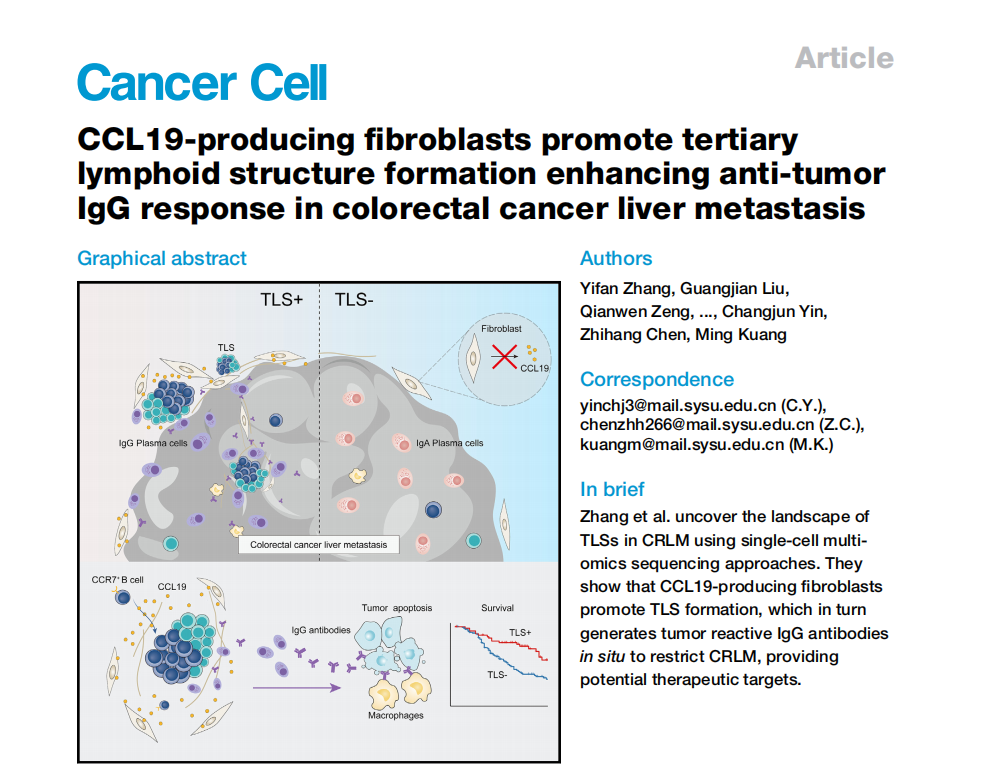All
Products
Resources
News
FAQ
Search
2024.08.12
Paper Review
Colorectal cancer (CRC) ranks as the fourth most prevalent cause of cancer-related mortality globally. CRC liver metastasis (CRLM) affects nearly 50% CRC patients and accounts for over 70% of CRC-related deaths. Currently, immunotherapies like immune checkpoint blockade (ICB) have revolutionized cancer treatment but show limited efficacy in CRLM. A deeper understanding of the metastatic microenvironment, specifically tertiary lymphoid structures (TLSs), which are linked to better immunotherapy response and survival in solid tumors, may offer new insights for CRLM treatment.
A recent paper published in Cancer Cell titled "CCL19-producing fibroblasts promote tertiary lymphoid structure formation enhancing anti-tumor IgG response in colorectal cancer liver metastasis”. By using single-cell multi-omics sequencing technologies like Stereo-seq,scRNA-seq, scBCR-seq, etc. along with patient-derived TLS-associated monoclonal antibodies, and humanized mouse models, researchers reveal the therapeutic significance, biological roles, and mechanisms of regeneration of TLSs in CRLM. They also proposed a comprehensive criterion to evaluate TLSs, helping to better classify patients. The study found a subset of CCL19-producing fibroblasts in CRLM, which might help form TLSs. These TLSs then generates tumor-reactive antibodies to constrain CRLM. These findings offer insights into the advancement of cancer therapies.

In this paper, Stereo-seq is used to identify the characteristics and functions of TLSs in CRLM. “As Stereo-seq shown, there were more IgG+ PCs aggregated in TLSs vicinity, while IgA+ PCs were scattered in non-TLS areas”. Moreover, Stereo-seq is utilized to validate the spatial distribution patterns of chemokines. “CCL19 was distributed within TLSs at all maturation stages, while, the distribution of CXCL13 associated with TLS maturation stages, these spatial distribution patterns of their mRNA were confirmed by Stereo-seq analyses. These data imply CCL19 may play major roles in the early stage of TLS formation, and CXCL13 may be crucial for TLS maturation.”
Know more about the research: https://www.cell.com/cancer-cell/abstract/S1535-6108(24)00271-X
About STOmics Stereo-seq:
As we dive deep into the spatial world, scientists often demand higher sensitivity and precision. STOmics now presents the upgraded Stereo-seq Transcriptomics Solution v1.3. This version delivers enhanced capture efficiency, broader compatibility, and a more streamlined workflow while minimizing the diffusion of mRNA molecules to achieve accurate spatial single-cell level analysis.
Find out more about Stereo-seq v1.3? https://en.stomics.tech/products/stereo-seq-transcriptomics-solution/list.html